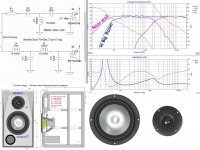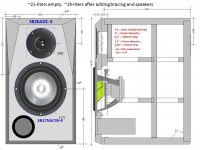Looking to build bookshelf speaker set. I know that the usual is full range for the low to mid and tweeter for the highs. My question is would it be good audio with woofer for low end and full range for mid to high? Most full range I see don't handle low end that well. Looking to do without a separate sub.
 Note: Title was changed partway through the postings.
Note: Title was changed partway through the postings.
 Note: Title was changed partway through the postings.
Note: Title was changed partway through the postings.A woofer and tweeter is usual for a bookshelf speaker, not a full range. A full range speaker with a woofer is an option and it often uses a much lower crossover frequency. Usually though, it would be a larger speaker or the woofer is more of a subwoofer and placed elsewhere.
SJ beat me to it, but I will add my take!
I would consider the 'usual' for a bookshelf speaker to be a combination of a mid/bass driver and a tweeter.
Nothing to stop you combining a 'woofer' with a full range speaker, but remember that a full range speaker may not give the smooth and extended treble response that's characteristic of a good tweeter.
I would consider the 'usual' for a bookshelf speaker to be a combination of a mid/bass driver and a tweeter.
Nothing to stop you combining a 'woofer' with a full range speaker, but remember that a full range speaker may not give the smooth and extended treble response that's characteristic of a good tweeter.
How large is your room?
Will the speakers be near the walls? Moved into the room?
What size cabinet fits your plans?
========
1) A 6.5" midbass in a ported 0.8cuft cabinet will produce -F3 = 42Hz. A 1700Hz crossover to 1" - 1.1" dome tweeter is common. If you move the cabinet into the room, you need a crossover which attenuates the midrange and high frequencies -6db to compensate for 360-degree bass.
SB_Acoustics (SB17NAC35-4 + SB26ADC-4 =$125) in a modest size cabinet is popular
===========
2) An 8" midbass like the SB_Acoustics SB23NACS45-4 in a ported 2cuft cabinet will produce -F3 = 33Hz. A 1200Hz crossover to a 1.1" - 1.2" dome tweeter, often in a waveguide, has gained interest. Wavecor has a 30 mm textile tweeter with waveguide TW030WA-11/12 which is designed for low frequency crossovers.
These are modest cost drivers($100 + $80), Based upon your amplifier power, you can select 4-ohm or 8-ohm drivers.
Will the speakers be near the walls? Moved into the room?
What size cabinet fits your plans?
========
1) A 6.5" midbass in a ported 0.8cuft cabinet will produce -F3 = 42Hz. A 1700Hz crossover to 1" - 1.1" dome tweeter is common. If you move the cabinet into the room, you need a crossover which attenuates the midrange and high frequencies -6db to compensate for 360-degree bass.
SB_Acoustics (SB17NAC35-4 + SB26ADC-4 =$125) in a modest size cabinet is popular
===========
2) An 8" midbass like the SB_Acoustics SB23NACS45-4 in a ported 2cuft cabinet will produce -F3 = 33Hz. A 1200Hz crossover to a 1.1" - 1.2" dome tweeter, often in a waveguide, has gained interest. Wavecor has a 30 mm textile tweeter with waveguide TW030WA-11/12 which is designed for low frequency crossovers.
These are modest cost drivers($100 + $80), Based upon your amplifier power, you can select 4-ohm or 8-ohm drivers.
The speakers will be mounted to one wall on a track so they are moveable to where I'm working.
Like that idea.

Example 2-way using 6.5" midbass and 1" tweeter in 0.8cuft. Does this match your goals?
SB_Acoustics (SB17NAC35-4 + SB26ADC-4 =$125) in a modest size cabinet.
Madisound has drivers in US.
=====
Do you need deeper bass from an 8" or 12" woofer in a larger(2cuft) ported cabinet?
SB_Acoustics (SB17NAC35-4 + SB26ADC-4 =$125) in a modest size cabinet.
Madisound has drivers in US.
=====
Do you need deeper bass from an 8" or 12" woofer in a larger(2cuft) ported cabinet?
Attachments
For on-wall mounting, you can put the port near the bottom of the front baffle, or near the bottom of the outer side panel. A 2" or 2.5" diameter port can be used. You can also plug the port to compare sealed box transients, or to use this speaker with a woofer. An aluminum cone is more durable and moisture resistant than a paper cone.
-F3 = 42Hz Flared Port exit
2” = 52mm diameter
6.5” = 166mm long
-----------------------------------------------
2.5” = 63mm diameter
10.6” = 270mm long
--------------------------------------------------------------------
–F3= 60Hz Sealed Port
Qtc = 0.57
Construction example:
Illuminator-Monitor
-F3 = 42Hz Flared Port exit
2” = 52mm diameter
6.5” = 166mm long
-----------------------------------------------
2.5” = 63mm diameter
10.6” = 270mm long
--------------------------------------------------------------------
–F3= 60Hz Sealed Port
Qtc = 0.57
Construction example:
Illuminator-Monitor
Attachments
...would it be good audio with woofer for low end and full range for mid to high?
A WAW. A very valid approach. A 2-way where the XO is low enuff that many of the issues you have with multiple ways and XOs.
Relieving the FR of bass duties really helps enhance their ability to do mid & top, really the biggest gain, and then the extra bass.
A bookeshelf is certainly possible.
We built an MTM with 2 x SilverFlute W14 and FF85wKeN. It was really outstanding.
But it doesn’t aways work out. We also did. small desktop WAW with a 3” TB “sub” and the FF85wKeN by itself in FH-Lite had better bass.
I now have my eyes set on a WAW with Alpair 5.xeN in it.
How big do you want? That will somewhat determine how much bass you can get.
Very often WAWs are XOed at line level with a separate amp for woofer & midTweeter. Althou one can fairly easily design a 1st order XO, trying to get a passive XO to work at the lower frequencies involved can be difficult and the parts are LARGE.
Fortuntly if you biamp you can get away with a PLLXO which costs almost nothing and adds none of the electronic haze any active XO gives. A fully active XO means more versatility, and better impedance matching. The Pass B4 kit should hit the diyAudio store soon. The existing LX-mini XO would work fine if you need less slope capability (but more spots for EQ built-in).
Perhaps the biggest issue is picking parts, in today’s world with many decent small FRs (and some outstanding ones) and even more small midbasses that can be used as woofers.
Having built many WAW i am firmly in this camp if you want to go beyond FR. The advantages of a FR driver with as much bass extention as you can afford (box size, driver, cost). I have grown to not really like typical “tweeters”.
dave
...will produce -F3 = 42Hz… produce -F3 = 33Hz
It is well worth noting that F3 is a meaningless spec to humans (Toole). It is only of importance to the XO so important for the FR part.
Best to specify F6 and/or F10. They give much more correlation with what we hear and an estimate of how much room gain wll play a role.
dave
Here’s the thing....replacing a dedicated tweeter with a full range driver has advantages and disadvantages......so pick your poisons!
Off axis treble response suffers with fullrange drivers, the larger the driver, the more beaming. This is subjective to the listener as less reflections from the room may be desireable.....or not?
Power handling suffers with a fullrange driver and in many cases, they are the limiting factor i overall system efficiency
Subjectively....one driver carrying the entire critical response range with no crossover has less phase anomalies and sounds more cohesive.......but again the room plays a factor.
Off axis treble response suffers with fullrange drivers, the larger the driver, the more beaming. This is subjective to the listener as less reflections from the room may be desireable.....or not?
Power handling suffers with a fullrange driver and in many cases, they are the limiting factor i overall system efficiency
Subjectively....one driver carrying the entire critical response range with no crossover has less phase anomalies and sounds more cohesive.......but again the room plays a factor.
power handling suffers with a fullrange driver
Not usually when supported by helper woofer(s).
And while despersion is in general poorer as d®iver size gets up, many of the small FR have essentially a 3/4” dome in the middle.
dave
The speakers will be mounted to one wall on a track so they are moveable to where I'm working.
I could understand that if your shop was big, but it's only 10' X 12'.
jeff
I use fullrangers in my workshop, and I'm always walking across the HF beam. But as it is background music there is something good about it over the larger spatial volume. Besides, if I really need to listen to that song I have a chair in the sweet spot next to a beer table.
- Status
- This old topic is closed. If you want to reopen this topic, contact a moderator using the "Report Post" button.
- Home
- Loudspeakers
- Multi-Way
- Speaker question: WAW / FAST

